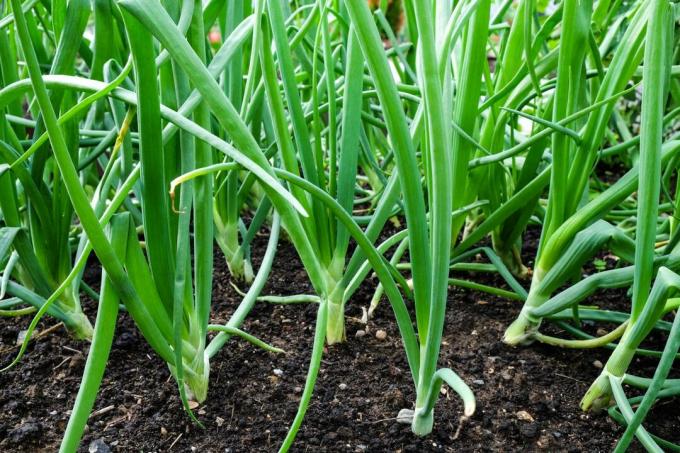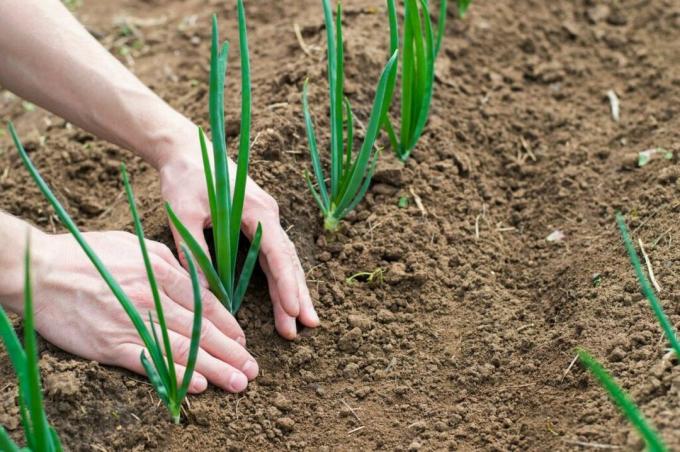Winter hedge onions are not very demanding vegetable plants and provide fresh spring onions for years. We give tips on growing and planting spring onions.

Actually, the healthy one should not be used in any garden Spring onion (Allium fistulosum) are missing for a very simple reason: it is a very undemanding vegetable culture, hardly needs any maintenance and you can have fresh and tasty spring onions throughout the gardening season to harvest. Also known as winter hedge onion, the hardy and perennial onion plant (Allioideae) can even be sown in autumn. We give tips on sowing and planting spring onions.
contents
- Planting spring onions: the right location
- Sow and plant spring onions
- Grow spring onions with onion sets
- Let the spring onions grow back
- Spring onions in mixed culture
Planting spring onions: the right location
In addition to the supply of light, the nature of the earth is also important. The ideal location for winter hedge bulbs is in full sun on loose, well drained and humus-rich soils. The spring onion does not tolerate heavy clay soils with a tendency to waterlogging or very sandy substrates due to the excessive or low water storage. Difficult soils can be overcome with a high-quality potting soil like ours
Plantura organic universal soil, be improved to enable the cultivation of winter hedge bulbs. Our completely peat-free substrates are produced in Germany in a climate-friendly manner and thus make a contribution to sustainable gardening. The high content of compost also promotes microorganisms and contributes to an improvement in the soil structure in the long term. In an optimal location and temperatures around 18 ° C, the spring onion develops particularly well.Spring onions can also be grown in the right place on the balcony in the tub or planter. A suitable pot for spring onions should hold around 10 liters of soil and be filled with nutrient-rich potting soil, ideally organic. You can also plant the spring onions on the raised bed. A selection of different Spring onion varieties for cultivation in beds and tubs can be found in our special article.
Sow and plant spring onions
The timing of sowing spring onions is very variable. Theoretically, it can take place between March and July as well as in autumn as winter sowing. At temperatures of 15 to 20 ° C, germination takes place on average after 14 to 28 days. In the open field, winter hedge bulbs are sown in rows or double rows with a row spacing of 30 to 40 cm. The sowing depth is about 1 to 2 cm. Use enough seeds when sowing the spring onions so that you can later isolate the plants at a distance of 2.5 cm in the row.

For a very early harvest or as a winter crop, the small seedlings are grown on a light window sill and planted out later. Multi-plates made of plastic, which consist of many small pots, are best for this. The advantage of this is that each spring onion is already growing in its own small pot. This prevents different plant roots from growing together. A nutrient-poor growing medium is ideal for the seeds of the winter hedge onion, as it promotes the formation of roots. After a cultivation period of about four weeks, the previously grown plants are planted in the bed at a distance of 2.5 cm. The young plants should be placed about so deep into the earth that the leaf roots remain uncovered.
Due to the long germination time, especially when sowing early outdoors with still low soil temperatures, it is advisable to sow so-called marker sowing. This refers to plants with faster germination and growth, which, so to speak, mark the point where the future spring onions will germinate. You can continue removing weeds and tending beds without worrying about the spring onion seeds being raked under. Suitable as marker seeds radish (Raphanus sativus), cress (Lepidium sativum) and spinach (Spinacia oleracea).

At a glance: sowing and planting spring onions
- Pre-cultivation of young plants for early harvest and as winter culture.
- Direct sowing in the bed between March and July.
- Pre-cultivate spring onions at 15 - 20 ° C and approx. 1 - 2 cm sowing depth.
- Winter onion seeds germinate after 14 to 28 days.
- After a four-week cultivation period, transplant the seedlings into the bed to just below the leaf base.
tip: Growing spring onions in double rows is particularly advantageous on small ridges. For this, two rows are laid out with a distance of 5 cm; the distance to the next double row should then be between 30 and 40 cm.
Grow spring onions with onion sets
Instead of just sowing, winter hedge onions can also be propagated using onion sets. The perennial onion plants form several, smaller daughter onions over time if they are not completely harvested as spring onions. By dividing the hive in autumn, you can continue to propagate the spring onions according to the variety and without much effort.

Let the spring onions grow back
Spring onions have a high regenerative capacity - they can sprout again after a strong pruning if the growth center of the plant is preserved. This sits at the foot of the plant a few centimeters above the roots. If rooted spring onions are cut back to 3 to 5 cm of the elongated onion, they can develop a new leek plant. Details on the subject Regrowing of vegetables you can find out in our special article.
Spring onions in mixed culture
A mixed culture of spring onions can keep diseases and pests away when combined with good neighbors. The mixed culture also ensures that the initially bare soil is protected from soil erosion. A good neighbor for spring onions is therefore the carrot (Daucus carota), but also other umbellifers (Apiaceae) such as parsnip (Pastinaca sativa) or parsley (Petroselinum crispum). You hold the onion fly (Delia antiqua) and at the same time benefit from the fact that the spring onion is the carrot fly (Psila rosae) sells. Leafy vegetables like lettuce (Lactuca sativa), Lamb's lettuce (Valerianella locusta) and spinach also go well with spring onions. Strawberries too (Fragaria) are good partners for growing spring onions.

Butterflies (Fabaceae), such as French beans (Phaseolus vulgaris) and peas (Pisum sativum), and also cabbage family (Brassicaceae). These should not be placed with spring onions, as they have similar space and soil requirements and therefore compete for light, water and nutrients.
After planting, you just need a little patience until it gets to the Harvesting and storing spring onions goes. With us you can find out everything about the harvest time, procedure and the optimal storage conditions.


